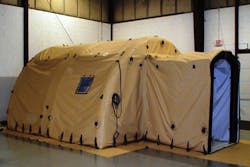Air-Inflated EMI Shelters
Saelig Company, Inc. has introduced inflatable AirBeam Enclosures for quick set-upElectromagnetic Interference (EMI) shielded, Radio Frequency Interference (RFI) shielded, or Chemical Biological Containment (CBC) enclosures, configured to rapidly deploy and provide an instant and uncomplicated state-of-the-art environment. These inflatables can be as small as 7x7-feet or as big as an aircraft hangar. Applications may include many types of EMI-RFI compliance testing, embassy or field military security, RF or radar interference shielding, EMI-RFI tolerance testing including HERO testing, secure TEMPEST communications, and field hospital or CBC uses with internal anti-microbial or other specialized fabric in place of the EMI-RFI shielded material. Usable in shipboard environments as well as in the field or inside buildings, these quick-inflate enclosures provide the vital security needed for an array of specialized operations.
AirBeam enclosures have air-inflated support beams, which offer the fastest set-up and strike time of any shelter, minimize the manpower needed for set-up, and are easily transported. These enclosures are tested to meet the highest military standards of quality and endurance, with an outdoor life in excess of 10 years. Many of these structures are currently in use in the harsh desert and high desert environments of Iraq and Afghanistan. They are treated to be fire-retardant and will remain inflated even after damage from small arms fire.
Designed with a variety on environments in mind, these shelters can withstand: two inches per hour of free falling and blowing rain for 30 minutes without intrusion of water into the shelter; 10 pounds per square foot of snow load for 12 hours without damage snow load; steady winds of 55 mph with gusts up to 65 mph for 30 minutes; temperatures of -40 F to 135 F; more than fifty erect/strike cycles without structural damage; blackouts - interior shelter lights are not visible during ingress/egress within 100 meters with the naked eye, or within 300 meters with night vision goggles.
An external foyer can be added to allow the user egress without having to interrupt operations or testing. This allows work to continue with no interruptions or loss of information. Built with heavy-duty Ni/Cu/Ag EMI shielding material sandwiched between layers of ripstop nylon fabric, these tents are tested to over 90 dB attenuation of signals from 10 MHz to 18 GHz under MIL-STD 285. The construction features a fire-retardant interior white wall. Standard features include an inflation blower and at least one man-door. Depending on the enclosure size and application, other features can be standard or optional, including foyers, large drive-through doors, shielded power and signal entry-exit plates, EMI-hardened Jameson lights or LED rope lights, shielded ventilation ports and exhaust ports with fans, vehicle exhaust ports, air conditioning, antenna mounts, anti-microbial interiors and other custom enhancements.
Smaller AirBeam enclosures can be setup by one person in as little as ten minutes. Durable ballistic fabric bags for transport or storage and hardened cases for shipping are provided.
